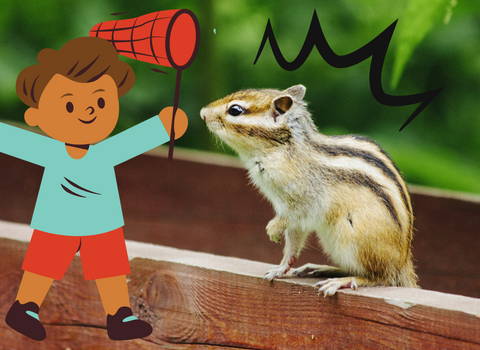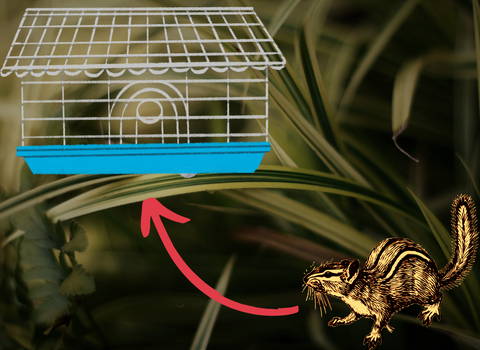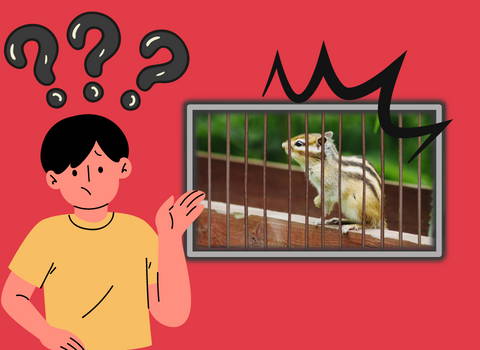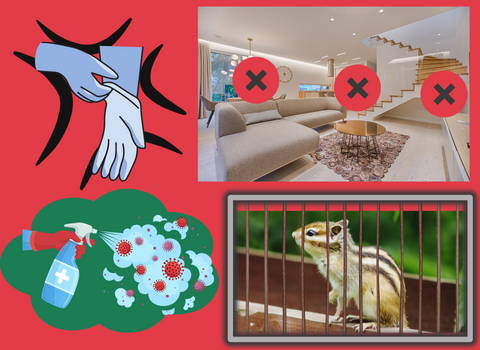How to Catch Chipmunks
Chipmunks look small and cute, but they can cause severe damage to your home if you leave them out of control. Ground squirrels and chipmunks are closely related, but the former is usually found in trees. Chipmunks, on the other hand, spend a lot of time in burrows.
The most common species of chipmunks are the least chipmunks and eastern chipmunks, which are frequently confused with red squirrels and striped gophers. Catching least and eastern chipmunks is not easy, but we will share some of the most humane and easiest ways to remove chipmunks.

Trapping Chipmunks
Trapping chipmunks are the easiest and most practical way of removing them from your home. You can use rat snap straps and cage traps like the Havahart cage trap to catch chipmunks.
There is also the Tomahawk cage trap with internal edges that prevent injury to trapped animals. These traps are available in local hardware stores, department stores, pest control companies, and farm stores.
Most of these traps are already fully assembled. You can also rent these traps from a local animal shelter and use them to trap rodents like flying squirrels and other small animals.

How to Lure Chipmunks into Traps
To lure them into the cage trap, you can use different baits, such as sunflower seeds or pumpkin seeds, nutmeats, prune slices, breakfast cereal grains, and raisins. You have to place the traps along the trails where you have seen the chipmunks often.
Trap movement can prematurely trigger the traps. To prevent this from happening and trap chipmunks successfully, consider pre-baiting the traps for two to three days by wiring the doors of the trap open. That way, the chipmunk will associate the traps with a new source of free food. You can set the traps once the chipmunks are actively eating the bait around and in the traps.
Always Check the Traps for Captured Chipmunks
It is important to check the traps often to get rid of captured chipmunks and remove non-target animals. Direct contact with the trapped chipmunk should be avoided. You need to get rid of them according to state regulations.
If they need to be euthanized, you can use carbon dioxide chambers. Always check the local laws and state laws about euthanizing methods for wildlife.
Alternative to Using Live Traps for Chipmunks
You can use rat snap traps to kill chipmunks, provided that they are isolated from pets, wildlife, and children. A rat trap can be set like a cage trap, but you must tie hard baits to the snap trap trigger. It is also important to pre-bait the trap.
Do not set the rat snap traps until the chipmunks have been conditioned to feed on the bait without any disturbance for two to three days. You have to place your snap traps perpendicular to chipmunk travel lanes with the snap trap triggers facing opposite directions. Setting the trigger arm is also essential so that it is easily sprung.
To prevent songbirds from getting caught in the chipmunk trap, consider placing the rat snap traps under a box with holes that allow only chipmunks to access them. There should be enough space inside the box, so the traps work properly.
If you placed the traps against the structure, you could hide them by leaning plywood or boards over them. Do not forget to put a small amount of bait at the opening to attract the chipmunks.
How to Catch a Chipmunk in House
Choose the Chipmunk Trap
To catch a chipmunk in your house, you need to choose a chipmunk trap first. The ideal trap is about 10” to 20” long. Small live chipmunk traps have a small mesh opening that prevents the animal from stealing bait or escaping.
One or Two-Door Traps
You can choose from one or two trap doors. The latter offers dual entry, increasing your catch rate. Two-door traps also allow you to set one or two doors open to trap chipmunks. One-door traps, on the other hand, are preferred for their simplicity. These traps allow you to place the bait at the farthest end of the trap, allowing for the best placement of bait like sunflower seeds.
Where Should You Place It
Once you have chosen the type of chipmunk trap, you will use, the next step is to determine where you will place it. Put the traps along trails or pathways with frequent chipmunk activity.
These animals are attracted to safe, covered areas like along fences or walls, below trees, chipmunk burrows, sheds, or attics, near brush, retaining walls, and underneath structures. They usually travel along fences or walls, especially when there is a covered area.
You can set two-door traps next to these constructions to catch chipmunks wandering in either direction.
Choosing the Right Bait
Now, it is time to choose the bait to make a more effective trap. Make sure it is something they cannot steal. For instance, if you will use solid baits, pick one that is larger than the trap’s mesh opening like unshelled peanuts.
If you prefer peanut butter, spread it directly onto the trap’s trigger plate. For bait placement, you need to do it in a manner that forces the animal to walk on the trigger plate.
Set Traps Carefully and Check them Constantly
Setting your traps may entail a careful balancing of door locks and rods, so make sure to follow the trap’s instructions. After setting the trap, gently press the trigger plate. Since small traps are sensitive to movements or vibrations, avoid disturbing the trap once you have put it in place.
You need to wait patiently. Do not forget to check the traps often since these animals can become anxious, starved, or dehydrated when left confined for an extended period.
What to Do If You Caught a Chipmunk
If you caught one, be gentle with them. Speak softly when handling or approaching the traps. You do not want to have direct contact with the chipmunk, so wear gloves when handling them.
As long as it is allowed by local laws, you can relocate the chipmunks at least five miles away from your house to prevent them from returning. After releasing them, wash the traps to prevent any disease from spreading. Do not forget to disinfect the traps as well.

How to Make Trapping Chipmunks More Effective
Since chipmunks love burrowing under a pile of debris, you need to remove the cover and unnecessary clutter in the yard to make your home less accessible for them and prevent chipmunks from coming back.
This will include removing brush piles or wood piles where they may hide and sealing off cracks or possible entry points in the property’s foundation. You also need to clean up pet food and birdseed and fix broken screens and vents, so they cannot access your house.
If you have a bird feeder, place them at least 15' away from your home or any structures so that it will not lure chipmunks to your property. You can also replace birdseed with thistle or any food that chipmunks hate.
Also, here are some tips to ensure a higher catch rate with a live trap.
Close all possible escape routes
Before trying to catch chipmunks indoors, it is essential to close off any cracks, doors, or holes that they can use to escape or access other parts of your house. Since they can enter quarter-sized holes, you should seal off all cracks you can find in your property.
Wear gloves when handling traps
Human scent can deter chipmunks from entering your traps due to their excellent sense of smell. Thus, cleaning the traps after every use should be observed. Wearing gloves when handling the traps should be done as well.
Wash and disinfect traps
Washing and disinfecting traps prevent the spread of diseases. Disinfect the traps by using a bleach solution made of water (9 parts) and bleach (1 part). Apply the bleach solution and leave it for 20 minutes before wiping it down. After removing the chipmunk, you can use an animal repellent to prevent them from returning.

Make a DIY Chipmunks Bucket Trap
If you prefer live traps, you can use a bucket trap. It is one of the most common rodent traps with a fairly high catch rate. The best part about this live trap is that it is made from items you can find around your house. Once the animal enters the trap and drops into the bucket, it cannot climb out.
First, you need to find where you will set it up. Check your flower beds or around your yard to find fresh chipmunk burrows.
Next, get a bucket. Put a thin stick across the bucket top then place a paint mixing stick perpendicular to the one you have just placed. That way, it will reach halfway across the opening of the bucket.
Next, create a DIY ramp-up to your mixing stick using a long wooden stick.
Finally, place a chipmunk attractant like sunflower seeds on the end of your mixing stick. The chipmunk will climb up your DIY ramp and walk on the mixing stick that is balancing over the thin stick. Once they cross the thinner stick, your mixing stick will flip, and the rodent will fall into the bucket. When this happens, it means the trap worked.

